Invasive Species: Acer ginnala, Amur Maple
Amur maple is an invasive multi-stemmed shrub or small tree that grows from 10 to 20 ft. (3 to 6 m) tall. The leaves are opposite and simple. They are three-lobed, doubly serrate, 1.5 to 3 in. (3.8 to 7.6 cm) long, and 3/4 to 1.5 in. (1.3 to 3.8 cm) wide. Flowering occurs in the spring, when small, yellowish white, fragrant flowers develop in small panicles. The fruit is a red to brown double samara. This species prefers moist, well-drained soils in full sun or partial shade. Amur maple is a native of northern Asia and was introduced in the United States as an ornamental plant around 1860.
What are invasive species, and why should we be concerned about them?
Taxonomy: Scientific and Common Names for This Species
Sapindales > Aceraceae > Acer ginnala Maxim.
Synonym(s): none
Acer ginnala – USDA PLANTS Profile
Distribution Maps
Amur maple – The reported distribution of this invasive species across the United States (Source: Invasive Plant Atlas of the United States)
Up-to-the-minute distribution maps and why they are important
Reporting This Invasive Species
What is the best way to report the occurrence of an invasive species?
How to report an invasive species sighting to EDDMapS – Early Detection & Distribution Mapping System
EDDMapS – Report an invasive species to EDDMapS.
County Extension Offices – Find your county Extension office on this map provided by USDA.
How to Identify
This invasive species can be identified by looking for the characteristics described in the paragraphs that follow.
Tree
Amur maple is a multi-stemmed tall shrub or small tree that grows from 10 to 20 ft. (3 to 6 m) tall.
 |
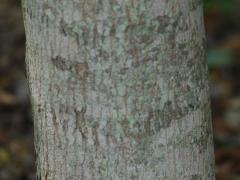 |
| Stacey Leicht, University of Connecticut, bugwood.org | Karan A. Rawlins, University of Georgia, bugwood.org |
Foliage
The opposite, simple leaves are three-lobed and doubly serrate. They are 1.5 to 3 in. (3.8 to 7.6 cm) long and 3/4 to 1.5 in. (1.3 to 3.8 cm) wide.
|
|
 |
| Paul Wray, Iowa State University, bugwood.org | Karan A. Rawlins, University of Georgia, bugwood.org |
Flower
Flowering occurs in the spring, when small, yellowish white, fragrant flowers develop in small panicles.
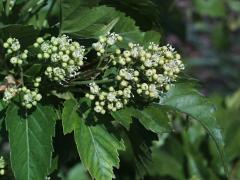 |
 |
| Paul Wray, Iowa State University, bugwood.org | Leslie J. Mehrhoff, University of Connecticut, bugwood.org |
Fruit
The fruit is a red to brown double samara.
 |
 |
| Paul Wray, Iowa State University, bugwood.org | Leslie J. Mehrhoff, University of Connecticut, bugwood.org |
Native Acer Species Resemble Amur Maple
Acer saccharinum, silver maple – Images at invasive.org
 |
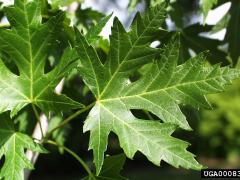 |
| Paul Wray, Iowa State University, bugwood.org | Paul Wray, Iowa State University, bugwood.org |
Acer rubrum, red maple – Images at invasive.org
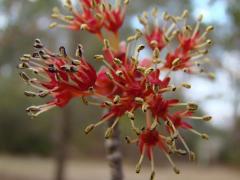 |
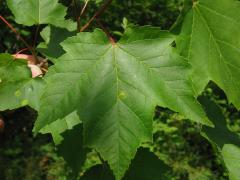 |
| Keith Kanoti, Maine Forest Service, bugwood.org | Rebekah D. Wallace, University of Georgia, bugwood.org |
Additional Images for Amur Maple
Amur maple – Images at invasive.org
Learning Resources for Amur Maple
Additional Information, Biology, Control and Management Resources
Control and management recommendations vary according to individual circumstances. Location, habitat, weather, and a variety of other conditions are factors that help determine the best treatment choice. To find the safest and most effective treatment for your situation, consult your state’s land-grant institution. If you will use chemicals as part of the control process, always refer to the product label.
United States Land Grant University System – Find your Land Grant University’s College of Agriculture, University Cooperative Extension Service, or other related partner on this map provided by USDA.
Invasive Plant Atlas of New England – University of Connecticut
Weed of the Week – USDA Forest Service
Invasive terrestrial plants – Minnesota Department of Natural Resources
Global Invasive Species Database – Invasive Species Specialist Group (ISSG)
Robert W. Freckmann Herbarium – University of Wisconsin, Stevens Point

